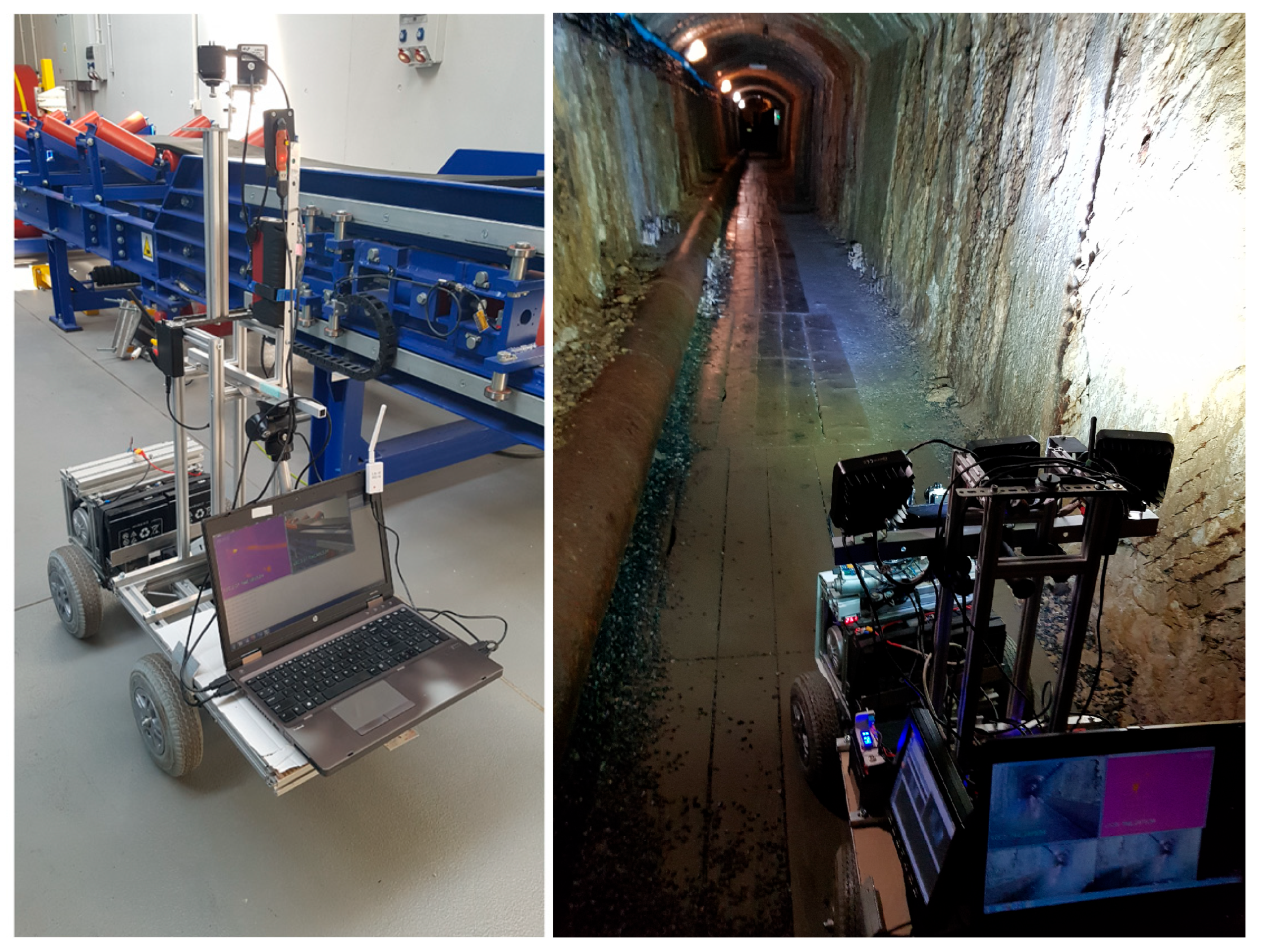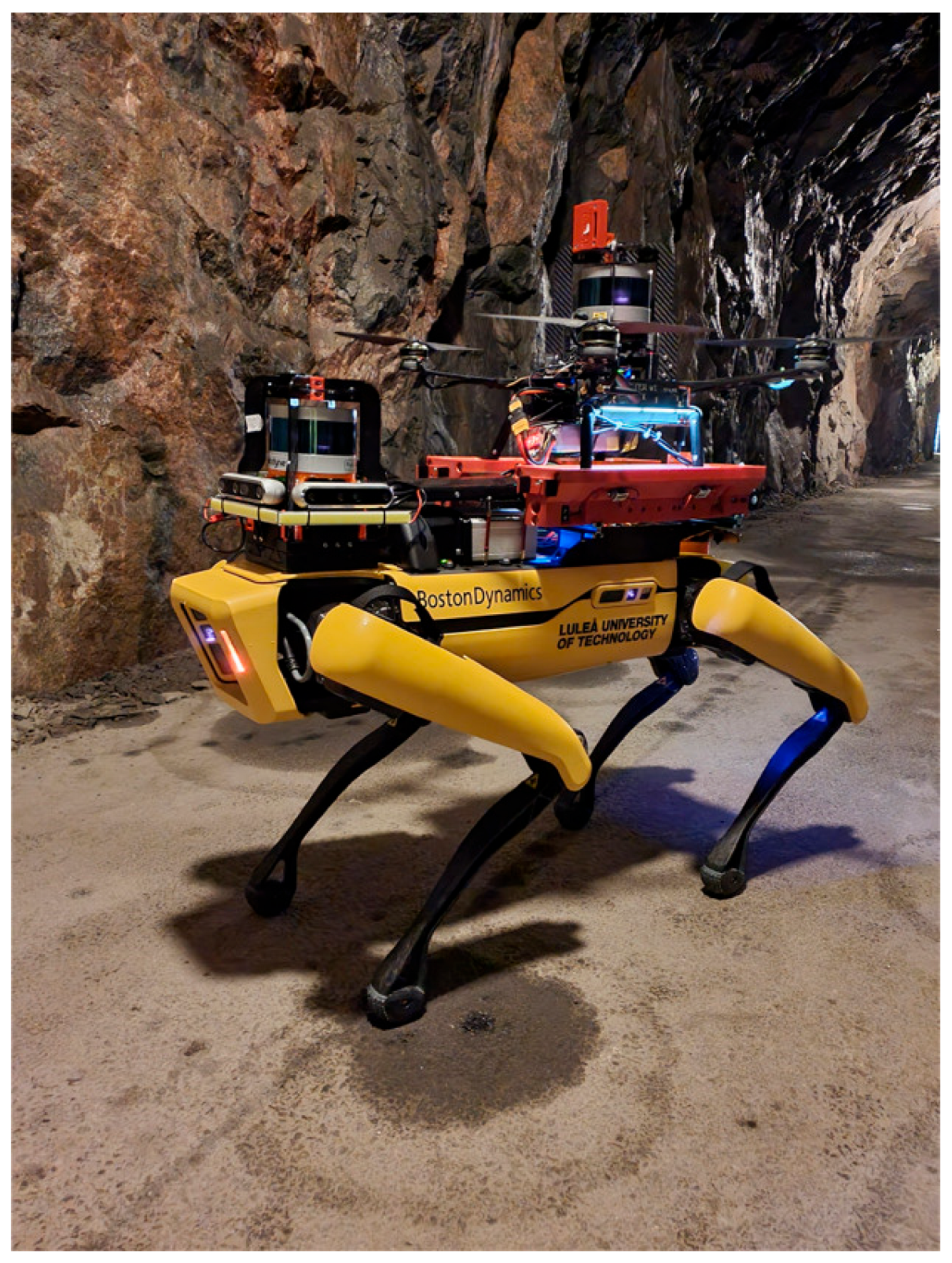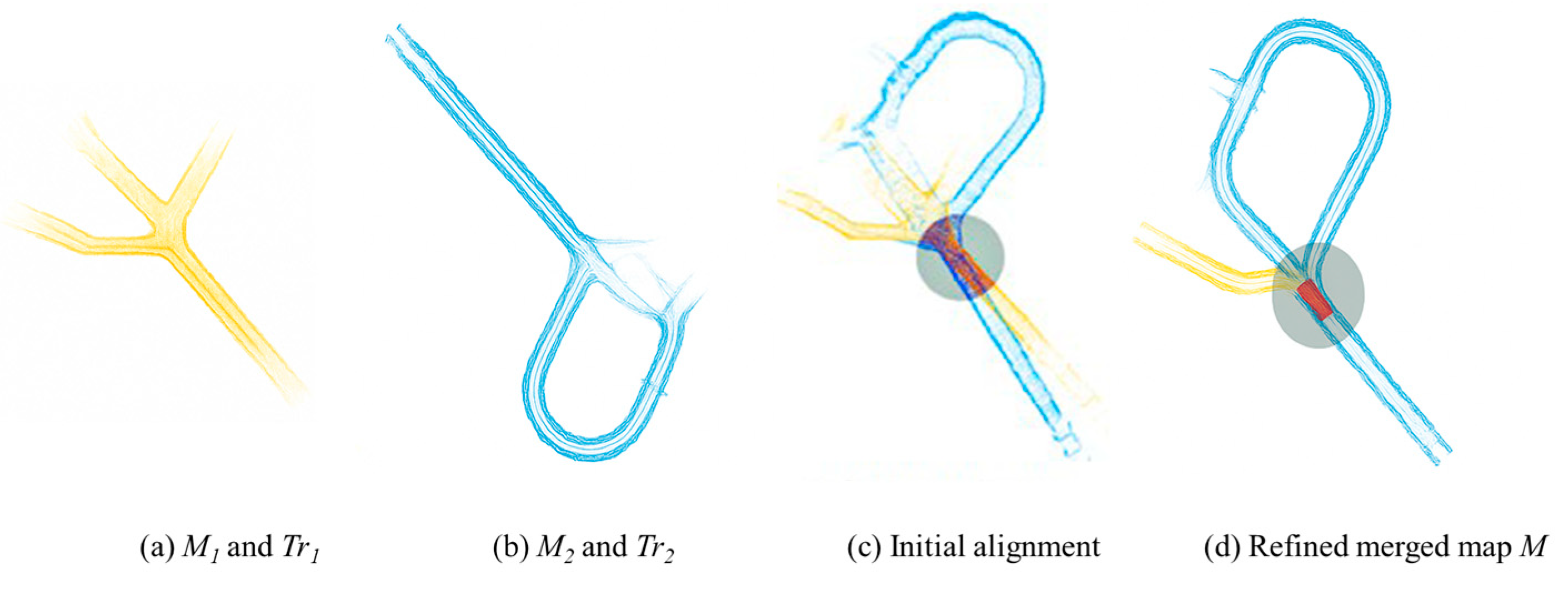Autonomous Mobile Inspection Robots in Deep Underground Mining—The Current State of the Art and Future Perspectives
Abstract
1. Introduction
2. Autonomous Solutions in Deep Excavation—Path Planning
3. Groundbreaking Technologies for Underground Mining Improvement
3.1. Identification of Hazards and Inspections of Mining Machines
3.2. Applications of Mobile Robot Solutions in Deep Underground Mining and Abandoned Mines
4. Multi-Machine Real-Time and Infrastructure-Free Mapping and Localization
- (a)
- Point cloud map of the area.
- (b)
- LiDAR scan.
- (c)
- Radar scan.
- (d)
- Inertial Measurement Unit (IMU) data.
- (e)
- Other parameters.
4.1. Infrastructure-Free Communication for Multi-Robot Systems
4.2. Multi-Robot Collaboration
5. Teleoperation and Digital Twin Technologies
6. Perspectives on Further Development of Autonomous Solutions for Mining
7. Discussion and Conclusions
Author Contributions
Funding
Conflicts of Interest
References
- European Commission. Directorate General for Internal Market, Industry, Entrepreneurship and SMEs. In Critical Raw Materials for Strategic Technologies and Sectors in the EU: A Foresight Study; European Commission: Luxembourg, French, 2020. [Google Scholar]
- Ashby, A.; Van Etten, E. Exploring Abandoned Mines through a Public Lens. In Proceedings of the 14th International Conference on Mine Closure, Ulaanbaatar, Mongolia, 17–19 August 2021; pp. 207–216. [Google Scholar]
- European Commission. Report on Critical Raw Materials and the Circular Economy; European Commission: Brussels, Belgium, 2018. [Google Scholar]
- Hojka, Z. Second Life of Post-Mining Facilities: Mines as a Tourist Attraction of Southern Poland. Stud. Hist. Oeconomicae 2023, 41, 121–142. [Google Scholar] [CrossRef]
- Konieczna-Fuławka, M.; Szumny, M.; Fuławka, K.; Jaśkiewicz-Proć, I.; Pactwa, K.; Kozłowska-Woszczycka, A.; Joutsenvaara, J.; Aro, P. Challenges Related to the Transformation of Post-Mining Underground Workings into Underground Laboratories. Sustainability 2023, 15, 10274. [Google Scholar] [CrossRef]
- Dvořáček, J.; Bauer, V.; Sousedíková, R.; Matušková, S.; Csikósová, A. Mine Closure and Resuming Production Options. Resour. Policy 2021, 74, 102323. [Google Scholar] [CrossRef]
- Zhao, J.; Gao, J.; Zhao, F.; Liu, Y. A Search-and-Rescue Robot System for Remotely Sensing the Underground Coal Mine Environment. Sensors 2017, 17, 2426. [Google Scholar] [CrossRef] [PubMed]
- Kim, H.; Choi, Y. Development of a LiDAR Sensor-based Small Autonomous Driving Robot for Underground Mines and Indoor Driving Experiments. J. Korean Soc. Miner. Energy Resour. Eng. 2019, 56, 407–415. [Google Scholar] [CrossRef]
- Alenezi, M.R.; Almeshal, A.M. Optimal Path Planning for a Remote Sensing Unmanned Ground Vehicle in a Hazardous Indoor Environment. Intell. Control. Autom. 2018, 09, 147–157. [Google Scholar] [CrossRef][Green Version]
- Ishigami, G.; Nagatani, K.; Yoshida, K. Path Planning and Evaluation for Planetary Rovers Based on Dynamic Mobility Index. In Proceedings of the 2011 IEEE/RSJ International Conference on Intelligent Robots and Systems, San Francisco, CA, USA, 25–30 September 2011; pp. 601–606. [Google Scholar] [CrossRef]
- Vagale, A.; Bye, R.T.; Oucheikh, R.; Osen, O.L.; Fossen, T.I. Path Planning and Collision Avoidance for Autonomous Surface Vehicles II: A Comparative Study of Algorithms. J. Mar. Sci. Technol. 2021, 26, 1307–1323. [Google Scholar] [CrossRef]
- Souissi, O.; Benatitallah, R.; Duvivier, D.; Artiba, A.; Belanger, N.; Feyzeau, P. Path Planning: A 2013 Survey. In Proceedings of the 2013 International Conference on Industrial Engineering and Systems Management (IESM), Rabat, Morocco, 28–30 October 2013; pp. 1–8. [Google Scholar]
- Sánchez-Ibáñez, J.R.; Pérez-del-Pulgar, C.J.; García-Cerezo, A. Path Planning for Autonomous Mobile Robots: A Review. Sensors 2021, 21, 7898. [Google Scholar] [CrossRef]
- Liu, T.; Huang, Z.; Wang, C.; An, Z.; Meng, X.; Zheng, J. Path Planning of Underground Mining Area Transportation Scene Based on Improved A* Algorithm. In Proceedings of the 2023 7th International Conference on Transportation Information and Safety (ICTIS), Xi’an, China, 4–6 August 2023; IEEE: New York, NY, USA; pp. 2265–2270. [Google Scholar] [CrossRef]
- Yulong, Q.; Qingyong, M.; Xu, T. Research on Navigation Path Planning for An Underground Load Haul Dump. J. Eng. Sci. Technol. Rev. 2015, 8, 102–109. [Google Scholar] [CrossRef]
- Zhang, C.; Yang, X.; Zhou, R.; Guo, Z. A Path Planning Method Based on Improved A* and Fuzzy Control DWA of Underground Mine Vehicles. Appl. Sci. 2024, 14, 3103. [Google Scholar] [CrossRef]
- Zhu, D.; Zhang, Y.; Wang, J.; Ren, K.; Yang, K. Evaluation of Motion Planning Algorithms for Underground Mobile Robots. In Intelligent Networked Things; Zhang, L., Yu, W., Jiang, H., Laili, Y., Eds.; Springer Nature: Singapore, 2022; Volume 1714, pp. 368–379. ISBN 9789811989148/9789811989155. [Google Scholar]
- Gu, C.; Liu, S.; Li, H.; Yuan, K.; Bao, W. Research on Hybrid Path Planning of Underground Degraded Environment Inspection Robot Based on Improved A* Algorithm and DWA Algorithm. Robotica 2025, 43, 887–908. [Google Scholar] [CrossRef]
- Zhang, S.; Zeng, Q. Online Unmanned Ground Vehicle Path Planning Based on Multi-Attribute Intelligent Reinforcement Learning for Mine Search and Rescue. Appl. Sci. 2024, 14, 9127. [Google Scholar] [CrossRef]
- Zhao, H.; Guo, Y.; Liu, Y.; Jin, J. Multirobot Unknown Environment Exploration and Obstacle Avoidance Based on a Voronoi Diagram and Reinforcement Learning. Expert Syst. Appl. 2025, 264, 125900. [Google Scholar] [CrossRef]
- Zhao, H.; Guo, Y.; Li, X.; Liu, Y.; Jin, J. Hierarchical Control Framework for Path Planning of Mobile Robots in Dynamic Environments Through Global Guidance and Reinforcement Learning. IEEE Internet Things J. 2024, 1, 309–333. [Google Scholar] [CrossRef]
- Ge, F.; Moore, W.; Antolovich, M.; Gao, J. Robot Learning by a Mining Tunnel Inspection Robot. In Proceedings of the 2012 9th International Conference on Ubiquitous Robots and Ambient Intelligence (URAI), Daejeon, Korea, 26–28 November 2012; pp. 200–204. [Google Scholar] [CrossRef]
- Fu, W.; Xu, Y.; Liu, L.; Zhang, L. Design and Research of Intelligent Safety Monitoring Robot for Coal Mine Shaft Construction. Adv. Civ. Eng. 2021, 2021, 6897767. [Google Scholar] [CrossRef]
- Kasprzyczak, L.; Trenczek, S.; Cader, M. Pneumatic Robot for Monitoring Hazardous Environments of Coal Mines. Solid State Phenom. 2013, 198, 120–125. [Google Scholar] [CrossRef]
- Berner, M.; Sifferlinger, N.A. H2020-ROBOMINERS Prototype Field Test. Berg Huettenmaenn Monatsh 2024, 169, 197–198. [Google Scholar] [CrossRef]
- Kim, H.; Choi, Y. Self-Driving Algorithm and Location Estimation Method for Small Environmental Monitoring Robot in Underground Mines. Comput. Model. Eng. Sci. 2021, 127, 943–964. [Google Scholar] [CrossRef]
- Mansouri, S.S.; Karvelis, P.; Kanellakis, C.; Koval, A.; Nikolakopoulos, G. Visual Subterranean Junction Recognition for MAVs Based on Convolutional Neural Networks. In Proceedings of the IECON 2019—45th Annual Conference of the IEEE Industrial Electronics Society, Lisbon, Portugal, 14–17 October 2019; pp. 192–197. [Google Scholar]
- Mansouri, S.S.; Castaño, M.; Kanellakis, C.; Nikolakopoulos, G. Autonomous MAV Navigation in Underground Mines Using Darkness Contours Detection. In Computer Vision Systems; Tzovaras, D., Giakoumis, D., Vincze, M., Argyros, A., Eds.; Springer International Publishing: Cham, Switzerland, 2019; Volume 11754, pp. 164–174. ISBN 9783030349943/9783030349950. [Google Scholar]
- Szrek, J.; Zimroz, R.; Wodecki, J.; Michalak, A.; Góralczyk, M.; Worsa-Kozak, M. Application of the Infrared Thermography and Unmanned Ground Vehicle for Rescue Action Support in Underground Mine—The AMICOS Project. Remote Sens. 2020, 13, 69. [Google Scholar] [CrossRef]
- Szrek, J.; Wodecki, J.; Błażej, R.; Zimroz, R. An Inspection Robot for Belt Conveyor Maintenance in Underground Mine—Infrared Thermography for Overheated Idlers Detection. Appl. Sci. 2020, 10, 4984. [Google Scholar] [CrossRef]
- Szrek, J.; Trybała, P.; Góralczyk, M.; Michalak, A.; Ziętek, B.; Zimroz, R. Accuracy Evaluation of Selected Mobile Inspection Robot Localization Techniques in a GNSS-Denied Environment. Sensors 2020, 21, 141. [Google Scholar] [CrossRef] [PubMed]
- Miller, I.D.; Cladera, F.; Cowley, A.; Shivakumar, S.S.; Lee, E.S.; Jarin-Lipschitz, L.; Bhat, A.; Rodrigues, N.; Zhou, A.; Cohen, A.; et al. Mine Tunnel Exploration Using Multiple Quadrupedal Robots. IEEE Robot. Autom. Lett. 2020, 5, 2840–2847. [Google Scholar] [CrossRef]
- Flyability. Available online: http://www.flyability.com (accessed on 1 September 2024).
- Kim, H.; Choi, Y. Comparison of Three Location Estimation Methods of an Autonomous Driving Robot for Underground Mines. Appl. Sci. 2020, 10, 4831. [Google Scholar] [CrossRef]
- Kim, H.; Choi, Y. Autonomous Driving Robot That Drives and Returns along a Planned Route in Underground Mines by Recognizing Road Signs. Appl. Sci. 2021, 11, 10235. [Google Scholar] [CrossRef]
- Trybała, P.; Szrek, J.; Remondino, F.; Wodecki, J.; Zimroz, R. Calibration of a multi-sensor wheeled robot for the 3d mapping of underground mining tunnels. Int. Arch. Photogramm. Remote Sens. Spatial Inf. Sci. 2022, XLVIII-2/W2-2022, 135–142. [Google Scholar] [CrossRef]
- Shiri, H.; Wodecki, J.; Ziętek, B.; Zimroz, R. Inspection Robotic UGV Platform and the Procedure for an Acoustic Signal-Based Fault Detection in Belt Conveyor Idler. Energies 2021, 14, 7646. [Google Scholar] [CrossRef]
- Dabek, P.; Szrek, J.; Zimroz, R.; Wodecki, J. An Automatic Procedure for Overheated Idler Detection in Belt Conveyors Using Fusion of Infrared and RGB Images Acquired during UGV Robot Inspection. Energies 2022, 15, 601. [Google Scholar] [CrossRef]
- Trybała, P.; Szrek, J.; Dębogórski, B.; Ziętek, B.; Blachowski, J.; Wodecki, J.; Zimroz, R. Analysis of Lidar Actuator System Influence on the Quality of Dense 3D Point Cloud Obtained with SLAM. Sensors 2023, 23, 721. [Google Scholar] [CrossRef]
- Milosevic, Z.; Fernandez, R.A.S.; Dominguez, S.; Rossi, C. Guidance for Autonomous Underwater Vehicles in Confined Semistructured Environments. Sensors 2020, 20, 7237. [Google Scholar] [CrossRef]
- Pan, H.; Tang, K.; Zhuo, J.; Lu, Y.; Chen, J.; Lv, Z. Underwater Acoustic Technology-Based Monitoring of Oil Spill: A Review. J. Mar. Sci. Eng. 2023, 11, 870. [Google Scholar] [CrossRef]
- Shahmoradi, J.; Talebi, E.; Roghanchi, P.; Hassanalian, M. A Comprehensive Review of Applications of Drone Technology in the Mining Industry. Drones 2020, 4, 34. [Google Scholar] [CrossRef]
- Gehring, C.; Fankhauser, P.; Isler, L.; Diethelm, R.; Bachmann, S.; Potz, M.; Gerstenberg, L.; Hutter, M. ANYmal in the Field: Solving Industrial Inspection of an Offshore HVDC Platform with a Quadrupedal Robot. In Field and Service Robotics; Ishigami, G., Yoshida, K., Eds.; Springer: Singapore, 2021; Volume 16, pp. 247–260. ISBN 9789811594595/9789811594601. [Google Scholar]
- Zimroz, R.; Hutter, M.; Mistry, M.; Stefaniak, P.; Walas, K.; Wodecki, J. Why Should Inspection Robots Be Used in Deep Underground Mines? In Proceedings of the 27th International Symposium on Mine Planning and Equipment Selection—MPES 2018, Las Condes, Chile, 19–23 November 2018; Widzyk-Capehart, E., Hekmat, A., Singhal, R., Eds.; Springer International Publishing: Cham, Switzerland, 2019; pp. 497–507, ISBN 9783319992198/9783319992204. [Google Scholar]
- Bayer, J.; Cížek, P.; Faigl, J. Autonomous Multi-Robot Exploration with Ground Vehicles in DARPA Subterranean Challenge Finals. Field Robot. 2023, 3, 266–300. [Google Scholar] [CrossRef]
- Thrun, S.; Thayer, S.; Whittaker, W.; Baker, C.; Burgard, W.; Ferguson, D.; Hannel, D.; Montemerlo, M.; Morris, A.; Omohundro, Z.; et al. Autonomous Exploration and Mapping of Abandoned Mines. IEEE Robot. Automat. Mag. 2004, 11, 79–91. [Google Scholar] [CrossRef]
- Lindqvist, B.; Bartolozzi, C.; Nikolakopoulos, G. Multimodality Robotic Systems: Integrated Combined Legged-Aerial Mobility for Subterranean Search-and-Rescue. Robot. Auton. Syst. 2022, 154, 104134. [Google Scholar] [CrossRef]
- Merkert, R.; Bushell, J. Managing the Drone Revolution: A Systematic Literature Review into the Current Use of Airborne Drones and Future Strategic Directions for Their Effective Control. J. Air Transp. Manag. 2020, 89, 101929. [Google Scholar] [CrossRef]
- NEXGEN. Robotized Inspection. Available online: https://www.nexgensims.eu/robotized-inspection/ (accessed on 10 April 2024).
- Rajant, PBE Group, and Australian Droid & Robot Make History with Successful Autonomous Remote Mine Inspection. Available online: https://rajant.com/rajant-pbe-group-and-australian-droid-robot-make-history-with-successful-autonomous-remote-mine-inspection/ (accessed on 18 October 2024).
- Losch, R.; Grehl, S.; Donner, M.; Buhl, C.; Jung, B. Design of an Autonomous Robot for Mapping, Navigation, and Manipulation in Underground Mines. In Proceedings of the 2018 IEEE/RSJ International Conference on Intelligent Robots and Systems (IROS), Madrid, Spain, 1–5 October 2018; IEEE: New York, NY, USA; pp. 1407–1412. [Google Scholar] [CrossRef]
- Olmedo, N.A.; Barczyk, M.; Zhang, H.; Wilson, W.; Lipsett, M.G. A UGV-Based Modular Robotic Manipulator for Soil Sampling and Terramechanics Investigations. J. Unmanned Veh. Syst. 2020, 8, 364–381. [Google Scholar] [CrossRef]
- Stathoulopoulos, N.; Koval, A.; Nikolakopoulos, G. 3DEG: Data-Driven Descriptor Extraction for Global Re-Localization in Subterranean Environments. Expert Syst. Appl. 2024, 237, 121508. [Google Scholar] [CrossRef]
- Davoli, L.; Pagliari, E.; Ferrari, G. Hybrid LoRa-IEEE 802.11s Opportunistic Mesh Networking for Flexible UAV Swarming. Drones 2021, 5, 26. [Google Scholar] [CrossRef]
- Ren, W.; Beard, R.W. Distributed Consensus in Multi-Vehicle Cooperative Control; Communications and Control Engineering; Springer: London, UK, 2008; ISBN 9781848000148/9781848000155. [Google Scholar]
- Lowe, R.; Wu, Y.; Tamar, A.; Harb, J.; Abbeel, P.; Mordatch, I. Multi-Agent Actor-Critic for Mixed Cooperative-Competitive Environments. Adv. Neural Inf. Process. Syst. 2017, 30. [Google Scholar]
- Rashid, T.; Samvelyan, M.; de Witt, C.S.; Farquhar, G.; Foerster, J.; Whiteson, S. Monotonic Value Function Factorisation for Deep Multi-Agent Reinforcement Learning. J. Mach. Learn. Res. 2020, 21, 1–51. [Google Scholar] [CrossRef]
- Foerster, J.; Farquhar, G.; Afouras, T.; Nardelli, N.; Whiteson, S. Counterfactual Multi-Agent Policy Gradients. Proc. AAAI Conf. Artif. Intell. 2018, 32, 2974–2982. [Google Scholar] [CrossRef]
- Gronauer, S.; Diepold, K. Multi-Agent Deep Reinforcement Learning: A Survey. Artif. Intell. Rev. 2022, 55, 895–943. [Google Scholar] [CrossRef]
- González, C.; Solanes, J.E.; Muñoz, A.; Gracia, L.; Girbés-Juan, V.; Tornero, J. Advanced Teleoperation and Control System for Industrial Robots Based on Augmented Virtuality and Haptic Feedback. J. Manuf. Syst. 2021, 59, 283–298. [Google Scholar] [CrossRef]
- Androulakis, V.; Bakzadeh, R.; Khaniani, H.; Shao, S.; Hassanalian, M.; Roghanchi, P. Robots in Mine Search and Rescue Operations: A Review of Platforms and Design Requirements. arXiv 2023. ahead of printing. [Google Scholar] [CrossRef]
- Shen, Y.; Li, Y.; Li, Z. Application of Intelligent Inspection Robot in Coal Mine Industrial Heritage Landscape: Taking Wangshiwa Coal Mine as an Example. Front. Neurorobotics 2022, 16, 865146. [Google Scholar] [CrossRef] [PubMed]
- Kaarlela, T.; Arnarson, H.; Pitkäaho, T.; Shu, B.; Solvang, B.; Pieskä, S. Common Educational Teleoperation Platform for Robotics Utilizing Digital Twins. Machines 2022, 10, 577. [Google Scholar] [CrossRef]
- Caiza, G.; Garcia, C.A.; Naranjo, J.E.; Garcia, M.V. Flexible robotic teleoperation architecture for intelligent oil fields. Heliyon 2020, 6, e03833. [Google Scholar] [CrossRef]
- Jansen, B.; Goodwin, T.; Gupta, V.; Kuipers, F.; Zussman, G. Performance Evaluation of WebRTC-based Video Conferencing. ACM SIGMETRICS Perform. Eval. Rev. 2018, 45, 56–68. [Google Scholar] [CrossRef]
- Available online: https://www.riotinto.com/en/news/stories/look-inside-future-mine (accessed on 21 May 2025).
- Yinka-Banjo, C.; Osunmakinde, I.O.; Bagula, A. Cooperative Behaviours with Swarm Intelligence in Multirobot Systems for Safety Inspections in Underground Terrains. Math. Probl. Eng. 2014, 2014, 678210. [Google Scholar] [CrossRef]
- Ge, L.; Fang, Z.; Li, H.; Zhang, L.; Zeng, W.; Xiao, X. Study of a Small Robot for Mine Hole Detection. Appl. Sci. 2023, 13, 13249. [Google Scholar] [CrossRef]
- Tauger, V.; Valiev, N.; Volkov, E.; Simisinov, D.; Adas, V. Remote-Controlled Robotic Complex for Underground Mining. E3S Web Conf. 2020, 177, 03006. [Google Scholar] [CrossRef]
- Tang, C.; Gao, E.; Li, Y.; Li, M.; Bai, D.; Tang, H.; Zhou, G. Inspection Robot and Wall Surface Detection Method for Coal Mine Wind Shaft. Appl. Sci. 2023, 13, 5662. [Google Scholar] [CrossRef]
- Rubio-Sierra, C.; Domínguez, D.; Gonzalo, J.; Escapa, A. Path Planner for Autonomous Exploration of Underground Mines by Aerial Vehicles. Sensors 2020, 20, 4259. [Google Scholar] [CrossRef] [PubMed]
- Ebadi, K.; Chang, Y.; Palieri, M.; Stephens, A.; Hatteland, A.; Heiden, E.; Thakur, A.; Funabiki, N.; Morrell, B.; Wood, S.; et al. LAMP: Large-Scale Autonomous Mapping and Positioning for Exploration of Perceptually-Degraded Subterranean Environments. In Proceedings of the 2020 IEEE International Conference on Robotics and Automation (ICRA), Paris, France, 31 May–31 August 2020. [Google Scholar]
- Kulkarni, M.; Dharmadhikari, M.; Tranzatto, M.; Zimmermann, S.; Reijgwart, V.; Petris, P.D.; Nguyen, H.; Khedekar, N.; Papachristos, C.; Ott, L.; et al. Autonomous Teamed Exploration of Subterranean Environments Using Legged and Aerial Robots. arXiv 2022, arXiv:2111.06482. [Google Scholar]
- Shurrab, M.; Mizouni, R.; Singh, S.; Otrok, H. Reinforcement Learning Framework for UAV-Based Target Localization Applications. Internet Things 2023, 23, 100867. [Google Scholar] [CrossRef]
- Skoczylas, A.; Stefaniak, P.; Anufriiev, S.; Jachnik, B. Belt Conveyors Rollers Diagnostics Based on Acoustic Signal Collected Using Autonomous Legged Inspection Robot. Appl. Sci. 2021, 11, 2299. [Google Scholar] [CrossRef]
- Xian, W.; Qi, Q.; Liu, Y.; Chen, C.; Liu, J. An Automatic Robot for Mine Inspection and Rescue Based on Multi-Sensor Fusion. In Proceedings of the Fourth International Conference on Sensors and Information Technology (ICSI 2024), Xiamen, China, 6 May 2024; Qiu, Z., Wu, L., Eds.; SPIE: Bellingham, WA, USA; p. 144. [Google Scholar]









Disclaimer/Publisher’s Note: The statements, opinions and data contained in all publications are solely those of the individual author(s) and contributor(s) and not of MDPI and/or the editor(s). MDPI and/or the editor(s) disclaim responsibility for any injury to people or property resulting from any ideas, methods, instructions or products referred to in the content. |
© 2025 by the authors. Licensee MDPI, Basel, Switzerland. This article is an open access article distributed under the terms and conditions of the Creative Commons Attribution (CC BY) license (https://creativecommons.org/licenses/by/4.0/).
Share and Cite
Konieczna-Fuławka, M.; Koval, A.; Nikolakopoulos, G.; Fumagalli, M.; Santas Moreu, L.; Vigara-Puche, V.; Müller, J.; Prenner, M. Autonomous Mobile Inspection Robots in Deep Underground Mining—The Current State of the Art and Future Perspectives. Sensors 2025, 25, 3598. https://doi.org/10.3390/s25123598
Konieczna-Fuławka M, Koval A, Nikolakopoulos G, Fumagalli M, Santas Moreu L, Vigara-Puche V, Müller J, Prenner M. Autonomous Mobile Inspection Robots in Deep Underground Mining—The Current State of the Art and Future Perspectives. Sensors. 2025; 25(12):3598. https://doi.org/10.3390/s25123598
Chicago/Turabian StyleKonieczna-Fuławka, Martyna, Anton Koval, George Nikolakopoulos, Matteo Fumagalli, Laura Santas Moreu, Victor Vigara-Puche, Jakob Müller, and Michael Prenner. 2025. "Autonomous Mobile Inspection Robots in Deep Underground Mining—The Current State of the Art and Future Perspectives" Sensors 25, no. 12: 3598. https://doi.org/10.3390/s25123598
APA StyleKonieczna-Fuławka, M., Koval, A., Nikolakopoulos, G., Fumagalli, M., Santas Moreu, L., Vigara-Puche, V., Müller, J., & Prenner, M. (2025). Autonomous Mobile Inspection Robots in Deep Underground Mining—The Current State of the Art and Future Perspectives. Sensors, 25(12), 3598. https://doi.org/10.3390/s25123598






